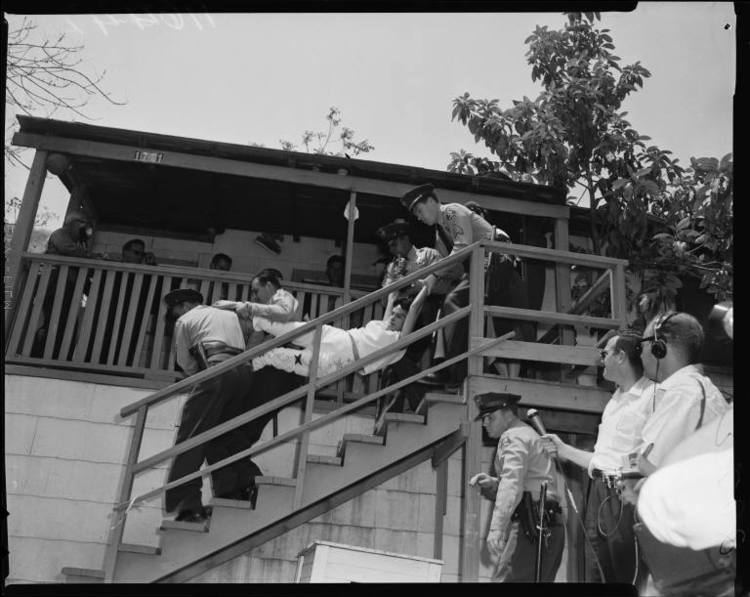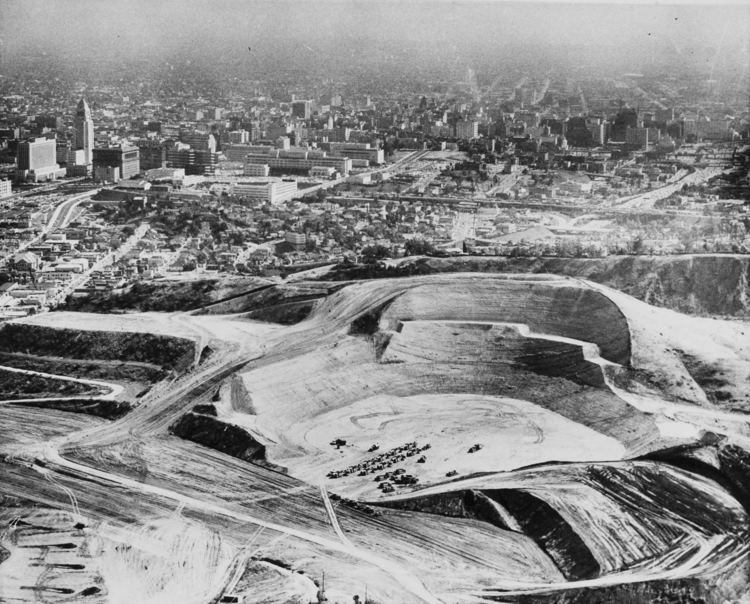 | ||
The battle of chavez ravine
Chavez Ravine is a shallow L-shaped canyon located in Los Angeles, California, United States, partially in the Elysian Park neighborhood. It sits in large promontory of hills north of downtown Los Angeles and was known in the 1860s as the "Stone Quarry Hills" which had other smaller ravines such as Sulphur Ravine, Cemetery Ravine, Solano Canyon and Reservoir Ravine. It is next to Dodger Stadium, a baseball venue that opened in 1962. The name Chavez Ravine can be used to mean either the actual ravine itself in a narrow sense or sometimes in a broader sense the entire promontory and surrounding ravines, and is also used to refer to the stadium. Dodger Stadium was constructed by knocking down the ridge which separated the nearby Sulfur and Cemetery Ravines and filling those two ravines in. Palo Verde Elementary School was buried in the process. Chavez Ravine was named for Julian Chavez, a Los Angeles councilman in the 19th century. Chavez originally purchased the land in the Elysian Park area, which eventually grew to about 315 acres, in 1844. Nearby "Cemetery Ravine" was named after old Calvary, the first cemetery of Los Angeles.
Contents

Ry cooder muy fifi 2005
1800s

Chavez Ravine was named for Julian Chavez, the first recorded land owner. He was born in New Mexico and moved to Los Angeles in the early 1830s. He quickly became a local leader. In 1844, Chavez purchased 83 acres of the long, narrow valley northwest of the city. There are no records of what Chavez did on his land, however during the 1850s and 1880s there were smallpox epidemics, Chavez Canyon, was the location of a "pest house" which cared for Chinese-Americans and Mexican-Americans suffering from the disease. The land was very rugged which prevented much development of the area. However the area did provide an important watershed and part was used by the Los Angeles Water Company for a canal bringing water from what is now Griffith Park and storing in a reservoir (today called Buena Vista Reservoir) in Reservoir Ravine. Some of Chavez Canyon and the surrounding hills became Elysian Park in 1886. That same year the two brick manufacturers moved into Chavez Ravine and began blasting operations in the hillsides.
1900s

By the early 1900s, in the hills above and around the ravine, a semi-rural Mexican-American community had grown up. Eventually, three distinct neighborhoods formed: Bishop, La Loma and Palo Verde, mostly on the ridges between the neighboring ravines. In 1913 a progressive lawyer named Marshall Stimson subsidized the movement of around 250 Mexican-Americans to these communities from the floodplain of the nearby Los Angeles River. There was a local grocery store, a local church, and Palo Verde Elementary. There was a nearby brick factory which caused local problems from the smoke and dust released. In 1926 the residents of Chavez Ravine organized to shut the company down. On August 20, 1926, the Los Angeles City Council unanimously adopted an ordinance prohibiting the blasting and zoned the area around Chavez Ravine for residential use.
1940s

Chavez Ravine was made up of the three mostly Mexican-American communities of La Loma, Palo Verde, and Bishop. In the 1940s, the area was a poor, though cohesive, Mexican-American community. Many families lived there because of housing discrimination in other parts of Los Angeles. With the population of Los Angeles expanding, Chavez Ravine was viewed as a prime, underutilized location. The city began to label the area as "blighted" and thus ripe for redevelopment. Through a vote, the Housing Authority of the City of Los Angeles, with the assistance of federal funds from the Housing Act of 1949, was designated the task to construct public housing, in large part to address the severe post-World War II housing shortage. Prominent architects Richard Neutra and Robert Alexander developed a plan for "Elysian Park Heights." The city had already relocated many of the residents of Chavez Ravine when the entire project came to a halt. Fear of communism was sweeping the United States and loud voices in Los Angeles cried that the housing project smacked of socialism.
1950s

The land for Dodger Stadium was purchased from local owners/inhabitants in the early 1950s by the City of Los Angeles using eminent domain with funds from the Federal Housing Act of 1949. The city had planned to develop the Elysian Park Heights public housing project which included two dozen 13-story buildings and more than 160 two-story townhouses, in addition to newly rebuilt playgrounds and schools.
Before construction could begin, the local political climate changed greatly when Norris Poulson was elected mayor of Los Angeles in 1953. Proposed public housing projects like Elysian Park Heights lost most of their support. Following protracted negotiations, the City of Los Angeles was able to purchase the Chavez Ravine property back from the Federal Housing Authority at a drastically reduced price, with the stipulation that the land be used for a public purpose. It was not until the baseball referendum Taxpayers Committee for Yes on Baseball, which was approved by Los Angeles voters on June 3, 1958 that the Dodgers were able to acquire 352 acres (1.42 km²) of Chavez Ravine from the City of Los Angeles. (The Dodgers, from 1958 to 1961, played their home games at the Los Angeles Memorial Coliseum.)
Los Angeles-based author Mike Davis, in his controversial, often polemical history of the city, City of Quartz, describes the process of gradually convincing Chavez Ravine homeowners to sell. In his book Davis asserts that with nearly all of the original Spanish-speaking homeowners initially unwilling to sell, "developers" representing the city and its public housing authority resorted to offering immediate cash payments, distributed through their Spanish-speaking agents. Once the first sales had been completed, it is said that remaining homeowners were offered lesser amounts of money, some speculate to create a community panic of not receiving fair compensation, or of being left as one of the few holdouts. Some residents continued to hold out, despite the pressure being placed upon them by such "developers," resulting in the Battle of Chavez Ravine, an unsuccessful ten-year struggle by a small number of remaining residents of Chavez Ravine to maintain control of their property, after the substantial majority of the property had been transferred to public ownership, during the period in which the city intended to use the land for the Elysian Park Heights public housing project.
In the end, the project died. A few years later, the city made the controversial decision to trade the land to the Brooklyn Dodgers and their owner Walter O'Malley, in exchange for land around the minor league park Wrigley Field, in a move to provide incentives for a migration to Los Angeles.
Later years
During the years when the Los Angeles Angels were tenants of the Dodgers (1962 through 1965), the Angels referred to the stadium as "Chavez Ravine Stadium" or simply "Chavez Ravine". Los Angeles City Council designated the property as "Dodgertown" in October 2008. The United States Postal Service assigned postal code "Dodgertown, CA 90090" in April 2009.
A number of structures from Chavez Ravine were spared demolition and sold by the developers of Dodger Stadium to nearby Universal Studios for one dollar apiece. Universal moved the structures to its back lot where they subsequently appeared in various Universal productions, most notably the 1962 film To Kill a Mockingbird. The house of Atticus Finch, for example, was an erstwhile Chavez Ravine home.
Today
Most of Chavez Ravine remains in Elysian Park where the The Chavez Ravine Arboretum still stands. The arboretum was founded in 1893 by the Los Angeles Horticultural Society where trees were added to through to the 1920s. Most of the Arboretum's original trees are still standing and many are the oldest and largest of their kind in California and even the United States . Further south in the ravine is Barlow Respiratory Hospital which was founded in 1902 and continues to treat patients today. At the open end of the ravine immediately adjacent to Dodger Stadium is the Naval and Marine Corps Reserve Center which was built in 1937 but is today a training facility, Frank Hotchkin Memorial Training Center, for the Los Angeles City Fire Department.
